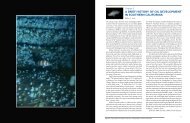checklist (pdf) - The Love Lab - University of California, Santa Barbara
checklist (pdf) - The Love Lab - University of California, Santa Barbara
checklist (pdf) - The Love Lab - University of California, Santa Barbara
You also want an ePaper? Increase the reach of your titles
YUMPU automatically turns print PDFs into web optimized ePapers that Google loves.
Order Anguilliformes<br />
Family Placement Uncertain<br />
Thalassenchelys coheni Castle & Raju, 1975. Leaflike Eel. To 30.4 cm (12 in) TL (Castle and Raju 1975).<br />
Western North Pacific to southern British Columbia (west <strong>of</strong> northern Vancouver Island at 49°59'N,<br />
130°32'W; Mecklenburg et al. 2002) and to Isla Guadalupe, central Baja <strong>California</strong> (Shimokawa et al.<br />
1995). Epipelagic. Known only from the leptocephalus (larva). Some specimens contain developing<br />
eggs, so transformation to “adult” features may not occur or the adult stage is short-lived (Eschmeyer<br />
and Herald 1983). Molecular data indicate a close affinity <strong>of</strong> T. coheni with the Serrivomeridae, but more<br />
eels need to be analyzed before making a definite family placement (Obermiller and Pfeiler 2003).<br />
Family Chlopsidae — False Morays<br />
*Chlopsis apterus (Beebe & Tee-Van, 1938). Stripesnout False Moray. To 25 cm (9.8 in) TL (Robertson<br />
and Allen 2002). Tip <strong>of</strong> Baja <strong>California</strong> (23°03'N, 109°28'W; Lavenberg 1988) and mouth <strong>of</strong> Gulf <strong>of</strong><br />
<strong>California</strong> to Colombia (Robertson and Allen 2002). At depths <strong>of</strong> 80–130 m (262–426 ft; Robertson<br />
and Allen 2002).<br />
*Chlopsis kazunoko Lavenberg, 1988. Kazunoko’s False Moray. To 12 cm (4.7 in) TL. Tip <strong>of</strong> Baja <strong>California</strong> and<br />
Jalisco, Mexico to Costa Rica. At depths <strong>of</strong> 50–100 m (164–328 ft). All in Robertson and Allen (2002).<br />
Family Muraenidae — Morays<br />
*Anarchias galapagensis (Seale, 1940). Hardtail Moray or Minute Moray. To 17 cm (6.7 in) TL (Robertson<br />
and Allen 2002). Lower Gulf <strong>of</strong> <strong>California</strong> (McCosker and Rosenblatt in Fischer et al. 1995) to Colombia<br />
(Robertson and Allen 2002), including tip <strong>of</strong> southern Baja <strong>California</strong> (Charter and Moser in Moser<br />
1996) and Islas Galápagos (Grove and Lavenberg 1997). At depths <strong>of</strong> 0–24 m (78 ft) (min.: Robertson<br />
and Allen 2002; max.: SIO 71-87).<br />
*Echidna nebulosa (Ahl, 1789). Snowflake Moray or Starry Moray. To 75 cm (29.5 in) TL (Myers 1999). Indo-<br />
Pacific; Kochi, Japan (Hatooka in Nakabo 2002); Cabo San Lucas, southern Baja <strong>California</strong> (McCosker<br />
and Rosenblatt in Fischer et al. 1995) to Colombia (Robertson and Allen 2002), including lower Gulf <strong>of</strong><br />
<strong>California</strong> (McCosker and Rosenblatt in Fischer et al. 1995). Surface (SIO 71-84) and intertidal to 30 m<br />
(98 ft) (min.: SIO 78-9; max.: <strong>Lab</strong>oute and Grandperrin 2000).<br />
*Echidna nocturna (Cope, 1872). Freckled Moray or Palenose Moray. To 75 cm (29.5 in) TL (Allen and<br />
Robertson 1994). Gulf <strong>of</strong> <strong>California</strong> (McCosker and Rosenblatt in Fischer et al. 1995) to Peru (Allen and<br />
Robertson 1994), including southern tip <strong>of</strong> Baja <strong>California</strong> (McCosker and Rosenblatt in Fischer et al.<br />
1995) and Islas Galápagos (Grove and Lavenberg 1997). At depths <strong>of</strong> 1–30 m (3–98 ft) (min.: SIO 62-9;<br />
max.: McCosker and Rosenblatt in Fischer et al. 1995).<br />
*Enchelycore octaviana (Myers & Wade, 1941). Slenderjaw Moray. To 93 cm (36.6 in) TL (Grove and<br />
Lavenberg 1997). Gulf <strong>of</strong> <strong>California</strong> (McCosker and Rosenblatt in Fischer et al. 1995) to Peru (Robertson<br />
and Allen 2002), including southern tip <strong>of</strong> Baja <strong>California</strong> (McCosker and Rosenblatt in Fischer et al.<br />
1995) and Islas Galápagos (Grove and Lavenberg 1997). At depths <strong>of</strong> 2–40 m (7–131 ft) (min.: SIO<br />
65-300; max.: Robertson and Allen 2002).<br />
*Gymnomuraena zebra (Shaw, 1797). Zebra Moray. To 150 cm (59 in) TL (Allen and Robertson 1994). Pacific<br />
and Indian oceans; Gulf <strong>of</strong> <strong>California</strong> (McCosker and Rosenblatt in Fischer et al. 1995) to southern tip<br />
<strong>of</strong> Baja <strong>California</strong> (McCosker and Rosenblatt in Fischer et al. 1995) and central America to Peru (Grove<br />
and Lavenberg 1997), including Islas Galápagos (Grove and Lavenberg 1997). At depths <strong>of</strong> 2–40 m (8–<br />
131 ft) (min.: SIO 59-216; max.: <strong>Lab</strong>oute and Grandperrin 2000). Also recently as Echidna zebra.<br />
17




